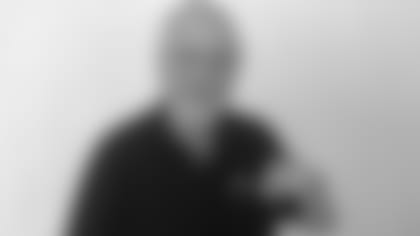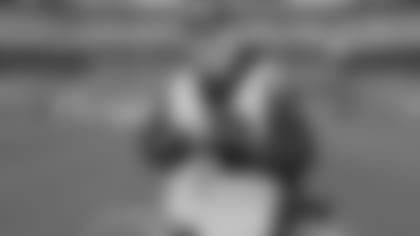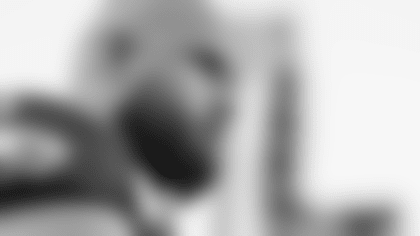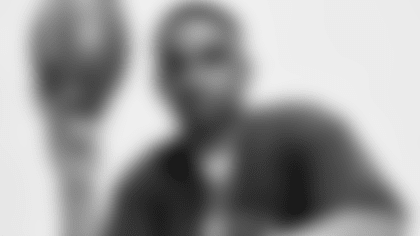An afternoon of stories from Ed Mahan will leave an Eagles fan in awe and a football historian fumbling for extra notepaper.
After 50 years as the Eagles' team photographer – the first in franchise history – those stories add up ...
and up ...
and up.
And if you're lucky enough to sit down with Mahan one day, you won't hear him brag or name-drop as he recounts experiences that will leave Eagles fans green with envy. Instead, you'll hear about how lucky he feels to have worked the best job in the world.
"You've got to pinch yourself once in a while," Mahan says. "The time blends together and it goes so quickly. But I've just been so blessed to do what I love and have fun doing it."
He'll tell you how it all started while painting the house of former Eagles general manager Jimmy Murray. Mahan was looking for work after he returned from Bronze Star service in Vietnam, where he picked up photography as a hobby. Murray and Art Mahan, Ed's father, became close friends working together at Villanova. Murray was the sports information director and Art Mahan worked as the Wildcats' baseball coach.
Murray heard of Mahan's new passion, saw his work from overseas, and told him they needed someone for the Eagles' last game of the regular season – December 20, 1970 against the Pittsburgh Steelers. Mahan's first game for the Eagles was the last game at Franklin Field.
The Eagles were impressed by his work. In the spring, Mahan picked up his next opportunity when he followed his dad to Houston and photographed Villanova's battle against John Wooden-led UCLA in the 1971 NCAA National Championship in men's basketball. It was a pretty good start to his career.
"Talk about being fortunate," Mahan says. "I was covering these high-level events just as I started in the business."
At that time, the Eagles had no dedicated team photographer. It was not a common practice in the NFL. A Rolodex – remember those? – sat in the Eagles' office from which freelance photographers were called upon on a game-by-game basis. The Eagles ditched the rotation and hired Mahan at the outset of the 1971 season.
Mahan was the first full-time photographer in Eagles' history and one of the first in the league. He worked every home game and coordinated all team photos. But Mahan will tell you he didn't truly know he was a photographer until Pope John Paul II came to Philadelphia in 1979.
Mahan tagged along with Murray to the Benjamin Franklin Parkway to see the pope and take pictures. When the pope took a detour and walked right by Murray, he stopped and blessed his son (named John Paul after the pope). Through the shock and excitement, Mahan stayed calm and snapped a remarkable photo that was featured the following week on Monday Night Football.
He'll also tell you about the time he made history by grabbing the only still images of Herman Edwards' fumble return to beat the New York Giants in 1978, dubbed the "Miracle of the Meadowlands." Every other photographer had packed up and gone to the dark room to develop their shots. Not only did the victory formation become a staple in offensive playbooks, but the "Ed Mahan Rule," to never leave a game early, was born.
"The credits were rolling on the screen on the broadcast," Mahan says. "Everyone thought that the game was over."
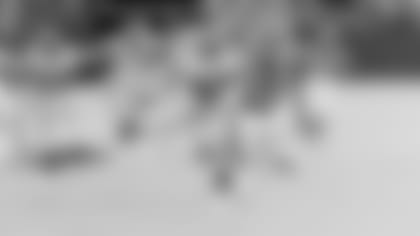
Right place at the right time
On November 19, 1978, Eagles team photographer Ed Mahan decided to use the final seconds of the Eagles-Giants game to get photos of a young player. Instead, he captured a miracle.
While holding the copy he keeps in his living room, Mahan glows when recounting his first big assignment: Eagle One. Mahan traveled to several star players' hometowns to photograph them in their element during the offseason and compiled them into a preseason team yearbook.
He rode his first horse with guard Wade Key. He avoided buffalo stampedes with linebacker Steve Zabel. He threw a football on the streets of New Orleans to wide receivers Harold Carmichael and Harold Jackson, along with record-setting kicker Tom Dempsey. He received a police escort through deep Mississippi to Ed Khayat's residence after a nerve-wracking pullover in the woods.
The work produced from these memorable trips became the blueprint for future team publications across the league, like the one you're reading right now.
"Owners are coming up to their PR directors like, 'The Eagles are doing this. Why aren't we doing this? What have we been doing in the offseason?'" Mahan says. "It really shook up the league."
He'll tell you about all the relationships he made along the way, while maintaining respect and what he calls "professional distance" from players and coaches. When Dick Vermeil was hired as the Eagles' head coach in 1976, he and Mahan built a friendship that lasts to this day.
Before games when Vermeil's stomach churned from nerves, he would go right to Mahan and ask him about his camera lens and which shots he was taking. It was the same set of questions every time but Vermeil said he needed to ask them to get his mind off football and relax.
Vermeil also recognized the importance of Mahan's work. On team photo days, an eye-roll for many coaches, Vermeil emphasized to his players that they would want this photo for the rest of their lives and should treat it with respect.
At one road game, Mahan stood close to the Eagles' sideline, aiming to get portraits for the yearbook, when security officials abruptly instructed him to leave the team area. Vermeil noticed and jogged over to firmly explain that Mahan was an Eagle. He was part of the team.
"'You leave him alone,'" Mahan recounts Vermeil yelling. "And, woah. Here's the head coach standing up for me. Who am I?"
When Vermeil led Eagles to Super Bowl XV, Mahan did more than just organize a team photo. He and Eagles' business manager Jim Borden went down to New Orleans a week before the game so Borden could handle important planning meetings regarding the game and festivities.
But when a family emergency suddenly arose for Borden, Mahan – yes, the team photographer – became the Eagles' lone team representative, making important decisions on behalf of the franchise.
"'You're in charge!'" Mahan remembers being told. "Could you imagine that today? Now they have meetings with 20 people for everything."
That could seem like a regrettable situation for a franchise in its most important week. But the Eagles' tight-knit front office had no doubt he could handle it.
"That's how much faith I had in giving him any assignment," Murray says. "When a family gets in trouble and somebody else has to do it, it isn't what your title is. It's just being there and knowing what the Eagles are all about."
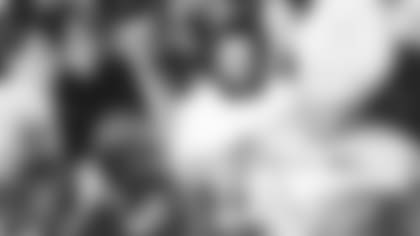
The GM, his son, and the pope: A truly one-in-a-million photograph
Nothing on the football field could have prepared Ed Mahan for what he encountered on the Benjamin Franklin Parkway in 1979.
Mahan quickly became a fixture in the Eagles organization and a massive part of Philadelphia sports history. At one point, he was a team photographer for all four Philadelphia professional sports franchises – at once. He still takes photos for Penn Athletics and the Penn Relays on the same field where he got his start 50 years ago.
Murray, who still receives a phone call each gameday from Mahan to check in, says that maybe other than Vermeil, Mahan is his best hire.
"People use the term eagle eye. Well, he is the Eagles' eye," says Philadelphia Hall of Fame journalist Ray Didinger. "The owners, coaches, and players, they come and go, but Eddie has been here the whole time. And because of him, we have this wonderful archive of photography that brings the whole history of the team to life."
The Super Bowl Champions edition of Didinger's book, The Eagles Encyclopedia, included a section about Mahan's life and work with the Eagles under the Front Office chapter. Didinger has also advocated for Mahan to write a book of his own with his photos and his stories.
"Fans have seen his work and they appreciate it greatly," Didinger says. "But in my view, not enough people know who Ed Mahan is."
While Mahan started as a one-man show, the Eagles' photo staff today is a well-oiled machine. Kiel Leggere, Drew Hallowell, Hunter Martin, Brian Garfinkel, and John Geliebter work with Mahan during home games and handle the work themselves on the road.
While his colleagues gush about his ability to take his work but not himself seriously, Mahan's personality alone did not get him through 50 years. Mahan knows where to be on the field to get an unorthodox shot at the right time. And before cameras were equipped were automatic focus, he still had the ability to work a lens and get the shot.
Before digital cameras, Hallowell sat with Mahan and developed rolls of film with 36 frames on them after games. Hallowell says his rolls would have one or two clear, well-composed shots. Ed's would have at least 30.
"It was much harder to be a photographer then because even if you had a sharp eye, your brain would have to tell your hands to move the camera into focus," Hallowell says. "That is the talent that I remember Ed had and probably still has."
The passion behind Mahan's work stems from an appreciation for what he does. It's why he always looks to lend a helping hand on the sideline, even to those who don't play for the same team.
When Philadelphia Inquirer staff photographer David Maialetti photographed his first Eagles game in the late 1990s, he says Mahan could sense it was his first game. While shooting his own photos, Mahan helped him get acclimated to the field and shared tips about his approach. His workplace did not matter.
"Sports photography is a very competitive field, much like competitive sports," Maialetti says. "So him doing that to make me feel welcome and showing me around a little bit, I've taken that as how I try to be like to all new photographers."
Mahan has consistently shown his team of photographers new ways to see the game and get the shot that no one else has. But after countless hours of stories shared in film rooms and in hotels on road trips, they've become a family and learned more from his friendly, personable nature.
"Ed's a people person," Martin says. "All he would have to do is tell a story to connect with someone. And players knew they were with someone down to earth who they could trust."
"I get calls from my parents and I get calls from Ed," Garfinkel says. "And we're having similar conversations about life."
Through the ups and downs, the milestones and magical moments, Mahan has never lost perspective. He knows both how important his job is and how lucky he is to do it. That was never more obvious than when President George W. Bush made an appearance at the Eagles' 2018 Salute to Service game against the Cowboys.
Mahan assigned Hallowell to photograph the President as he walked onto the field. When Hallowell introduced himself in the tunnel, President Bush asked what his job was. He explained that he was a team photographer for the Philadelphia Eagles.
"Wow," the President replied. "What a cool job."
That inspired a postgame speech from Mahan.
"We are so fortunate that the President of the United States thinks we have a cool job," Mahan says. "I told my guys, don't take it for granted and try to share it. Bring others into our world and be the gracious holders of that title."
If you're lucky enough to sit down with Mahan one day, you'll hear all of these stories and more. Through his years of work, he is both proud and grateful for what he has experienced as the Eagles' photographer. But after 50 years of experiences and personal relationships, the stories are what he holds closest to his heart.
"My dad always said you can lose money, you can lose whatever, but they can't take your memories away," Mahan says. "Those are yours forever. And I'm lucky to have made so many great ones."
